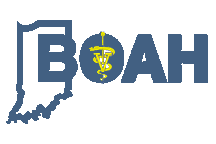Pork producers place a high value on the health status of their animals. Owners of hogs certified as free of certain diseases may reap the benefits of that status when swine are moved across state lines or exhibited at livestock shows.
Validated-Qualified (VQ) Herds
The following overview highlights testing requirements for establishing a Validated Brucellosis-Free and Qualified Pseudorabies-Negative (QN) swine herd. An application for both programs is available from the Indiana State Board of Animal Health.
Establishing a VQ Herd
To establish a VQ breeding herd status, a negative blood test must be conducted on:
All breeding swine over six months old, and
A number of offspring between four months and six months old, equal to 20 percent of the breeding swine population (e.g. 70 progeny from a 350-sow herd).
The herd must have been free of pseudorabies for at least 30 days, and at least 90 percent of the herd on the premises for 60 days or longer as part of the herd.
When all swine are shipped directly from existing VQ herds, a new VQ breeding herd can be established.
When qualifying a grow-out or sales point (from which finished gilts or boars are moved to slaughter or sale) that is geographically separate from the main herd, the lesser of 50-head selected at random or the entire initial shipment must test negative.
Maintaining a VQ Herd
VQ herds must be blood-tested on a continuing basis to keep their qualification. Test schedules are either monthly or quarterly.
MONTHLY TESTING: Tests must be completed at 25-day to 35-day intervals (with 12 tests completed in a calendar year) on:
Seven percent of all breeding swine over six months old, and
A number of offspring between four months and six months of age equal to two percent of the breeding herd located on the same premises.
Gilt or boar grow-out sites that are geographically separate from the breeding herd (no breeders are housed on-site) must be maintained by testing 50 randomly selected hogs each month.
On permission of the state veterinarian, larger, multisite operations may maintain qualification by:
Conducting a random test in each separate population of breeding swine over six months of age (fewer than 100 head-test 45; between 100 head and 200-head-test 51; between 201-head and 999-head-test 57; and more than 1,000-head-test 59), and
Test 50 offspring aged four months to six months located on the same premises as the breeding herd.
QUARTERLY TESTING: Tests may be completed at 80-day to 105-day intervals on:
20 percent of all breeding swine more than six months old, and
A number of offspring between four months and six months of age, located on the same premises, equal to six percent of the breeding herd.
Gilt or boar grow-out sites for quarterly tested VQ herds must adhere to monthly test guidelines.
Herd Additions
Once VQ status is established, isolation and testing of new herd additions is required. Under Indiana law, incoming animals must be tested negative within 30 days prior to sale, if they do not originate from another VQ herd.
Upon arrival, animals must be isolated for 30 days before introduction into the herd. Although not required, isolation of VQ-source animals is recommended. Those hogs must be retested before they are exposed to the main herd, 30 days to 45 days after arrival.
New additions are eligible for testing with the main herd 60 days after joining the herd.
Qualified Negative Gene-Altered Vaccinated Herd (QNV)
Under some circumstances, a herd owner may prefer to vaccinate his swine herd against PRV. A Qualified Negative Gene-Altered Vaccinated Herd (QNV) option gives that flexibility with the use of a g1 gene-altered vaccine.
Establishment and maintenance of a QNV herd is the same as that of a QN herd, with one exception: The QNV herd must test negative for PRV before the breeding herd is vaccinated, if the herd's PRV status is unknown.
The g1 vaccines must be used, because they can be distinguished from the pseudorabies virus in approved laboratory testing.
NOTE: Some states do not recognize the QNV status, and require an individual negative test of animals from QNV herds, prior to exhibition or sale in their state.
